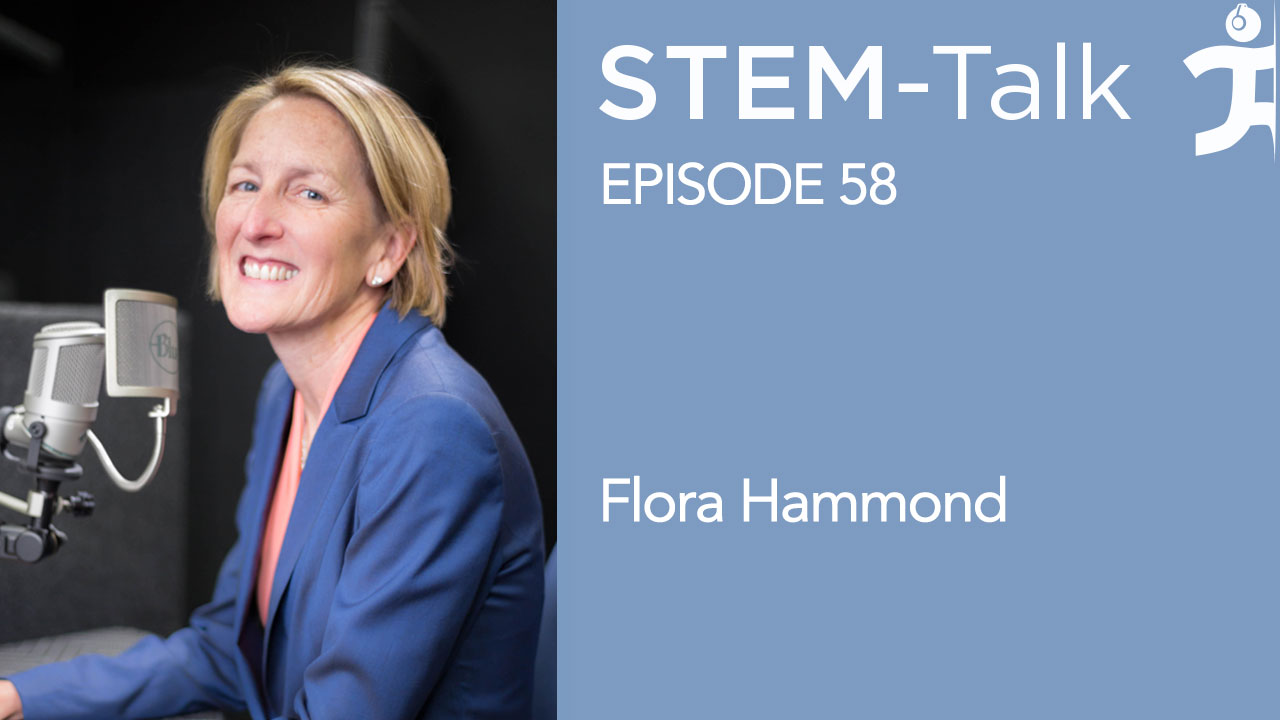STEM-Talk
Episode 58: Flora Hammond discusses traumatic brain injuries and how treatments are evolving
// Feb 27, 2018

Today’s episode features one of the nation’s leading physicians and researchers who has spent years studying and treating traumatic brain injuries.
Dr. Flora Hammond is a professor and chair of the Department of Physical Medicine and Rehabilitation at Indiana University School of Medicine. She also is the Chief of Medical Affairs and Medical Director at the Rehabilitation Hospital of Indiana. She has been a project director for the Traumatic Brain Injury Model System since 1998.
Shortly before we conducted this interview with Dr. Hammond, she and a team of physicians and scientists at Indiana University received a $2.1 million grant to continue research into people who suffer traumatic brain injuries and how these injuries affect the lives of patients as well as their families.
Dr. Hammond is a Pensacola, Florida, native who graduated from the Tulane University School of Medicine in 1990 and completed her residency in Physical Medicine and Rehabilitation at the Baylor College of Medicine in Houston. She also completed a brain injury medicine fellowship at Wayne State University School of Medicine in Detroit. Her research in the area of brain injury includes studying the prediction of outcome, aging with brain injury, causes of and treatments for irritability, and quality of relationships.
In 2016 she received the Robert L. Moody Prize, which is the nation’s highest honor reserved for individuals who had made exceptional and sustained contributions to the lives of individuals with brain injuries.
Prior to the 2016 Robert L. Moody Prize, Dr. Hammond received local and national awards for her teaching, clinical care and research, including the 2001 Association of Academic Physiatrists Young Academician Award, the 2011 Brain Injury Association of America William Caveness Award, and the 2013 Baylor College of Medicine Distinguished Alumnus Award.
In 2011, 2012, and 2013, Dr. Hammond led the Galveston Brain Injury Conferences which focused on changing the view of brain injury as an incident with limited short-term treatment to a chronic condition that must be proactively managed over the course of life.
She co-chairs the American Congress of Rehabilitation Medicine Chronic Brain Injury Task Force, and serves on Journal of Head Trauma Rehabilitation editorial board. She has authored more than 140 peer-reviewed publications.
Links:
Flora Hamond faculty profile:
https://medicine.iu.edu/faculty/20302/hammond-flora/
“Potential Impact of Amantadine on Aggression” study
https://www.ncbi.nlm.nih.gov/pubmed/28891908
Show notes:
4:08: Interview begins.
4:38: Dawn says it’s her understanding that Flora dreamed of becoming a physician ever since middle school. Dawn asks what inspired her at such an early age to become a doctor.
5:02: Flora talks about also wanting to become a teacher, but worried that she would have to give up teaching to become a doctor.
5:40: Continuing with Flora’s history, Dawn mentions that after high school Flora traveled to New Orleans to attend Tulane University. Dawn asks if it’s true that Flora’s grandmother was her landlord while she was in college and med school.
6:20: Ken mentions that Flora’s mother was a dietician and that her father was a pathologist. He asks Flora what specifically inspired her to specialize in brain injury rehabilitation and research.
8:36: Dawn comments on how before Flora accepted a positon at Indiana, she was in the Carolinas, and asks about her work there.
9:30: Dawn asks how Flora ended up at the Indiana University School of Medicine.
10:23: Ken mentions that Flora’s lecture at IHMC attracted a lot of interest and a full-house. He follows up by asking Flora what she thinks is driving the interest in brain injuries.
11:34: Dawn talks about how Flora and a team of physicians and scientists at Indiana have spent years studying and treating TBI (Traumatic Brain Injury) and the effects of TBI on the lives of patients and their families. She goes on to mention that Indiana recently was awarded a $2.1 million grant to continue those studies for the next five years. Dawns asks Flora to talk about the scope of the work she will be doing as a result of the grant.
12:57: Ken mentions that Flora has pushed to have a national approach to the treatment of TBI, where patients and physicians continuously track the injury and continue treatments. He asks her to expand on her thoughts on such a program and how more people and organizations can start working toward an integrated approach.
13:48: Dawn asks for Flora to explain the different types of brain injury, and to clarify that TBI is not merely one singular disease or type of injury process. Flora goes on to explain the difference between mild, moderate and severe injuries, and then describes how the treatments differ.
14:50: Dawn asks Flora how she diagnoses the severity of TBI, and if there are any biomarkers that are currently in use.
16:01: Dawn asks what common issues patients struggle with after a traumatic brain injury.
17:08: Dawn proposes the hypothetical scenario of a patient coming into Flora’s rehabilitation clinic, and asks Flora to walk us through an example of how they would treat that person and what program they would go through.
19:21: Ken mentions that there are a number of TBI centers that focus on integrative medicine, and rather than just treating the brain injury they are now treating the patient as a whole human being. He talks about optimizing sleep, proper nutrition, and ways to manage aggression and anxiety in addition to specific treatment of the brain. He asks Flora how much does it seem that physicians are currently integrating these approaches into TBI treatment around the country.
20:17: Dawn asks what we know about the triggers of irritability and aggression in TBI patients, and if there is a biochemical component to these triggers or if it is something else.
22:21: Dawn inquires as to the different ways that Flora uses to track a patient’s condition on the cognitive or emotional level.
22:45: Flora talks about research on aging after TBI, and that interestingly enough, it’s not always about worsened outcomes. Some people actually get better over time, while others stay the same or their condition even worsens over time. Dawn asks if there are ways to differentiate who will improve and who will worsen with time.
23:50: Ken comments on how in the past it was thought that brain plasticity, and thereby recovery, was more plausible for a child with TBI, but that recovery would plateau at some point. He points out, however, that much of Flora’s work has shown that recovery can occur in older individuals and they can continue to improve long after the initial injury. He asks Flora if she could talk about that work.
24:44: Dawn asks if there is a difference in treatment for a child with TBI compared to an adult with a similar injury.
25:17: Ken mentions that ApoE 4/4, and even 3/4 status, has been shown to be a genotype that is associated with worsened patient outcomes after TBI, and that there are other genetic variables beyond ApoE that are relevant. He asks, in regards to the era of precision medicine, are we looking at these genetic variables with respect to a personalized patient treatment program?
26:21: Ken asks if we are able to accurately predict outcomes in the early hours and days following the injury.
27:00: Dawn asks if a severe brain injury typically implies a poorer outcome.
27:36: Mentioning that she has several people close to her with various types of TBI, Dawn talks about how she loves the idea of a participatory research system that Flora has proposed and implemented. Dawn asks Flora to expand on this approach to TBI research.
28:31: Ken talks about how Flora has focused a lot of her research on non-pharmacological interventions for TBI. He asks for some examples of approaches that she has studied, and if those approaches are being harnessed by the general TBI treatment community.
29:33: Ken mentions that Flora recently published a study on the promising ability of the drug Amantadine to curb aggression in TBI patients. He asks if she could elaborate on that.
33:27: Dawn comments on how in most treatment modalities for brain injury, the focus is on the acute phase. She asks how can treatment be extended after the initial management, and what else does Flora think long-term treatments for TBI patients should include.
34:13: Dawn asks if it is true that all of the recovery from a brain injury happens within the first year.
35:08: Dawn asks if medication in the early recovery phase has a downside in the long term.
36:01: Ken mentions that a number of therapies for TBI that showed great promise in animal studies, failed to yield the hoped-for results in human trials. He asks what are the current barriers to developing new acute therapies that reduce morbidity and mortality in TBI patients are.
37:09: Ken comments on how TBI is an injury to the brain, but it also affects a variety of other systems and pathways in the body. He mentions that the Hypothalamic Pituitary Adrenal access can often be impacted in TBI patients. He asks for a brief explanation of the HP access and how damage to it can affect the patient.
38:38: Ken asks if there would ever be a case where a person with HPA access as their dysfunction could be misdiagnosed with TBI and vice versa?
39:24: Dawn mentions that it seems as though the HPA axis has been widely ignored, comparatively speaking, to other metrics in TBI patients. She asks if we are starting to include its assessment and status in patients, as far as tracking is concerned.
39:52: Dawn comments on how Flora has coined the term CBI (Chronic Brain Injury). Dawn asks if CBI has been incorporated into a public health and societal approach, in addition to traditional medicine.
40:37: Ken asks Flora to elaborate on how she would scope and define CBI as opposed to TBI.
41:17: Dawn asks for Flora to talk about how brain injury rehab has evolved over her career.
42:21: Dawn congratulates Flora on receiving the Robert L. Moody Prize last year, which is the nation’s highest honor for individuals who have made exceptional and sustained contributions to the lives of people with brain injuries. She follows up by asking for some background on the award itself.
42:48: Dawn asks where Flora sees the field of TBI research and rehabilitation heading in the next 10 years.
43:48: Dawn closes by asking Flora how she likes to spend her free time.






